Good morning-
You really need to discuss this with your vet as they know your pet best. Everyone/thing is unique and reacts in their own way. I would talk with the vet and also ask about other methods of pain relief. Best of luck.
Hi Dr Magnifico. Our once feral cat Daisy has been going to her litter box all day every 2-5 minutes trying to urinate. Only a small drop or two comes out. She looks like she is in pain. We brought her in a couple years ago for this. She is extremely hard to get in a carrier or trap to bring her in and she is untouchable, she is still very feral like.
Can you prescibe the same thing she was prescibed before? I am going to have a very hard time getting her in a carrier or trap to bring her in, and she needs medication ASAP.
Terri Stiffler
Comments
My dog was Originally prescribed Gabapentin (50mg) every 12 hours but when I went back to the vet they allowed Me to do every 6 hours instead because pain seemed to be coming back faster. Now it seems the pain meds are not helping at all even with putting him to sleep. Can I give it even sooner than every 6 hours? My dog is 8.10 lbs.
Comments
We believe our 3 year old French bulldog has IVDD related issue based on the exam at the emergency vet tonight.
We want to do everything we can as soon as we can. I spoke to a neurologist who said they won’t see him until he is referred by his primary vet. Just within the last 8 hours of this happening it appears he has loss all use of his hind legs. I’m not quite sure if this sign of paralysis or what I should be looking for. He is panting quite a bit from the pain so I’m assuming the paralysis hasn’t kicked in. We were given two prescriptions to follow through with until we can get him into a doctor on Monday. Is this going to be soon enough? We have pet insurance but also want to be sure it will cover the cost of the surgery if needed.
Comments
My cat got a FLUTD diagnosis yesterday morning after spending the night in the animal hospital because they were checking for an obstruction. He hadn’t obstructed, but they couldn’t get enough urine for a urinalysis, so when we picked him up yesterday morning they gave us a container. I got a hair under 3ml, dropped it off and was told they’d run it and let me know if it was enough but I have yet to hear if anything has come from it. He’s on an anti-inflammatory and a muscle relaxant. He’s a very vocal and clingy cat, but he’s been very quiet since we brought him home. He produced a decent amount of urine yesterday, but he hasn’t done more than a little dribble for about 4 hours now. I was told, if there were no additional or worsening symptoms, to bring him in immediately if this reaches 12 hours with no output. He doesn’t yell or talk or grunt when he’s in the litter, just stays there for a while and scrunches his back up as he tries to go but can’t, and will turn around frequently. He’s walking normally and isn’t having trouble getting to sleep, he’s eating normally and drinking frequently.
I was advised to start a vet prescription diet made up of 90% Hills Science Metabolic Urinary Care + CD dry food and 10% wet food, but the vets didn’t have any and after making a few calls around, was told my best option was to order it online and wait. Waiting is very stressful, and I’d really like to know if there is anything else I can do in the meantime to prevent any further discomfort or an obstruction. I would also like to know if there is a safe way to get him to the animal hospital the fastest. I’m worried if he’s obstructed, picking him up and carrying him or putting him in his cage might cause even more pain or make his urethra rupture.
Any additional tips or advice is very much appreciated. Thank you for your time.
Comments
My dog is on day 9 after being diagnosed with ivdd . He was walking a lot better after losing mobility in his right front and back leg but today it looks like he’s losing the mobility in his 2 front legs all over again. What happened?? He was doing so well. His pain looked like it had gone away and he was sleeping through the night without the pain killer.
Comments
Hi, I have a 15 year old chihuahua named Peanut. He was diagnosed with IVDD on Sunday. He is able to stand for 30 seconds on his own and can walk a few steps before falling over. His right front leg and right back leg are the main limbs that knuckle over and give out when he stands. He can’t get himself to an upright standing position. He is currently on Gabapentin and galliprant. When the pain killers don’t have him knocked out he is crying and whimpering. He looks like he is pain and can’t get in a comfortable position . He is eating and drinking water. He is able to use pee and defecate on his own but most of the time does it while he’s laying down in his pen.
I feel so bad for him I’m honestly just crying all the time because it hurts to see him in pain and I feel helpless. I try and let him stand and walk for a few
Minutes a day with my support but should I be letting him walk? Or should I be trying to make him rest more? Also he doesn’t let me switch the side he lays on. He only lays on his right side . I know Dr. Krista said we need to switch the aside they lay on but he looks like he’s in more pain when I try to switch him to the left.
Any advice , thoughts, or feelings? I really just needed to not feel so alone in this.
Comments
Kitten with completely atonic colon, possible causes? (Long text ahead)
So Nov. 3th in the evening we got 2 kittens, estimated 6 weeks old, thin. However due to being cold outside they already had very thick fur, so it wasn’t visible how thin they were. Weight was 550 & 650gr.
The finder said they have been more active before and only now they were able to get those two. They borrowed to live traps to get the mother and another kitten.
Both were seen eating. They were treated against worms (Milbemycinoxim/Praziquantel) and fleas (Lotilaner)
Nov 4th: Overnight everything was eaten, poo was solid. Kittens were responsive and alert. To the evening only half was eaten. Poo was still solid.
Nov 5th: Nothing was eaten over night, the little one seemed a bit weaker. I started to feed them with a syringe. They started with diarrhea, but that sometimes happens when feeding with a syringe.
Nov. 6th: They still don’t eat by themselves. The smaller one still seemed weaker, but otherwise it seemed fine. A bit diarrhea. In the evening I found it the litter box, not being able to stand, barely reacting. It hat vomited (at least it looked like it), and still had poo stuck on it. It was immediately brought to a vet. It received glucose solution s.c., something against vomiting, pain and an antibiotics. Lung sounded free, heart (ultrasound) was fine, too. A test of parvovirosis came back negative. I took both of them home that night, so I could feed it smaller portions more often and to give more fluids. 2 hours later to was able to stand again. I fed them every 3-4 hours, fluids every 6 (only small amounts obviously). It was lying on a warmth mat. The bigger one was fine, but avoided it’s litter mate.
Nov. 7th: No further improvement. None of them was eating on their own. The smaller one was still lying down most of the time, sleeping, but would react when I came to feed them. It would stand up and walk to the litterbox between the feedings, but the poo had a weird consistency. Not really diarrhea, but veeeery sticky, so it always carried it back to it’s sleeping place. So I had to clean it before every feeding. A test on giardia was positive, treatment started with Carnidazol. Continue to feed them with a Syringe and fluids for the smaller one. Fluids were always absorbed to the next feeding, but it still was a bit dehydrated (skin fold test). The bigger one would play in between and seemed fine otherwise.
Nov. 8th: No changes in the smaller one during the day, still weaker, able to walk, sit and stand, but sleeping most of the time. Today there was rarely poo in the toilet. I assumed that the treatment started working and it was a good sign (although I already had the feeling that something was wrong… wish I would have trusted that feeling). In the evening it seemed weaker, but would still accept being fed with a syringe. It felt different, less body tension, but would still walk away/go to the t. 10pm feeding. More calm, didn’t want to eat that much, peed on me. Meowed louder during giving the fluids than usual and tried to get away. 2am clock, the fluids weren’t absorbed completely, it’s abdomen felt like a sponge. I only fed a tiny amount. 6am weaker, would lie down immediately, breathing was shallow and faster, meowing, I didn’t feed it, fluids still not absorbed. Rushed to the vet.
-> Heart had a low frequency, breathing fast and shallow
-> X-Ray lungs were free, only a tiny amount of fluids in the abdomen, however the complete colon and stomach were filled with food. There was no visible blockage or air.
-> Ultrasound: Absolutely no movement in the colon/stomach, no blockage or air seen either. Kidneys and liver seemed fine
-> Punctation of the abdomen: ca. 3-4ml of fluids, lots of proteins, a bit of blood. Didn’t look like FIP. Possible that the fluids came out of the colon.
It was given something against vomiting, pain, antibiotics, something to help the cardiovascular system and something to get the colon moving again. To help with its breathing got a mask with additional oxygen. However in the next hour it got worse, so we decided to let it go. After it was gone food came back out of it’s mouth. And it didn’t even smell like it had started to digest.
It’s littermate is still with me and fine. It started to eat on its own yesterday.
Now I obviously ask myself what i could have done better/different. By now I think I should have started with additional syringe feeding earlier – at least with the smaller one. And I should have reacted when my feeling told me that something was wrong, even when there were no obvious changes yet. I somehow have the feeling that I sis something wrong and killed it. Did I give too much fluids (but lungs were free and only a bit fluid in the abdomen)? Did I feed too much? Other kittens eat even more without problems – and the other one is fine.
And what can be the causes for the complete stop of movement in the colon/stomach?
I know that FIP can cause this and an ileus (but there were no visible blockage, everything was filled with food), are there other causes? Can giardia do this?







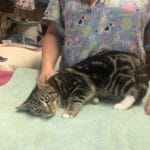
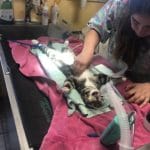
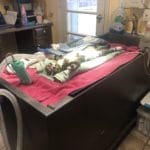
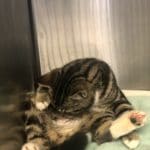

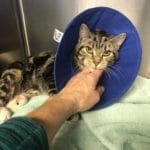



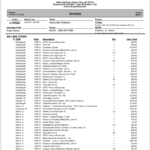



Hello,
I am away from the office and on vacation.. but even if I wasn’t I would be very afraid that she might be blocked (unable to pass urine) versus having an infection or inflammation. If she is blocked she will need immediate assistance from a veterinarian. She may even need sedation or anesthesia to place a catheter. Certainly blockage is more common in males but we can’t assume she isn’t in an immediate medical emergency and that’s why we all get so worried about assuming it’s not something dangerous or life threatening and just prescribing blindly. Anytime a cat is in the litter box frequently and not producing much or any urine we worry about blockage.
As you are a client of the clinic I will have someone call you tomorrow to discuss options. But to be on the safe side I have to strongly recommend she be seen. And I cannot even assure you that tomorrow is safe to wait for.
I wish you all well and I hope she is ok. Please pm us on Facebook for private assistance.
Sincerely
Krista.